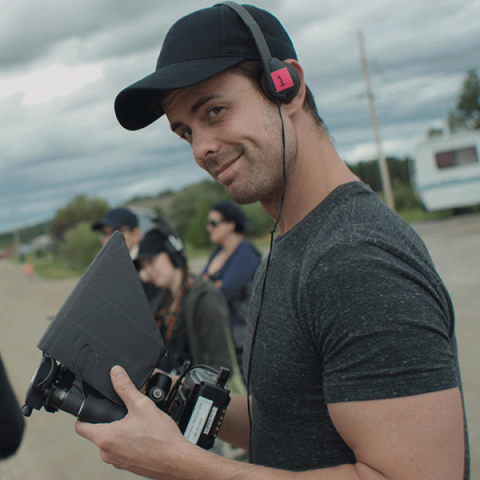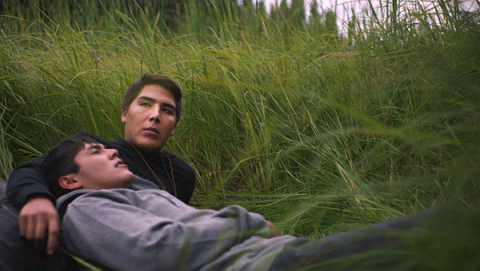
The weighty stories that are woven between his life and those around him through the looming background narrative are beyond tragic. You begin to intuitively believe that these situations are far from fiction. Jones convinces the viewer that beyond homophobia, there are severe tragic realities facing First Nation’s people off-screen daily in this country.
You would think that introducing the topics of homophobia, suicide, depression, substance abuse, cyclical trauma and sexual violence within the first 15 minutes of a film would make it emotionally exhausting and contrived, but it never comes off that way. Fire Song leaves you with an understanding and empathy for the suffering of a people that have been violently robbed of their heritage and identity through colonialism and how the impact of that theft still immensely affects indigenous people to this day, especially their youth.
Samaritanmag spoke with Jones, who is of Cree and Métis ancestry and also identifies as gay.
Did any of the film feel autobiographical?
Pretty much nothing. I made the film and I connected with the story really as a result of connecting with the main character Shane. I didn’t grow up on reserve, but I struggled with depression and suicide since I was about six years old and that went through my teens and twenties. When I got a little bit older and started working with youth and talking with more youth, and talking with more people in the indigenous communit,y I started to hear how common the experience of suicide really is. So I started working on these characters and went from there.
The film is described as an LGBT drama, but it didn’t feel like that to me. It felt much more universal than that.
This perhaps doesn’t feel like a queer film as a primary label, probably because usually when you’re watching LGBT films about young people, they tend to be about coming out stories and this is really a story about grief. Queerness is definitely part of the experience of the main character in the film, but you’re dealing with a lot of stuff simultaneously. And that’s what I remember from being a young person, really feeling like there’s so much going on, all at once, in life and that all the contributing factors tend to create this kind of a pressure cooker where suicide is so prevalent and feels so possible as an option for young people. It boils down to much more than just one thing.
There seems to be an underlying disdain towards him for wanting to leave, to escape. Is that connected to suicidal thoughts in these young folks? Feeling as though you’re abandoning your community, or that you’re some kind of traitor when you’re just attempting to find a better life? Do you think this is part of the emotional struggle that can lead to suicide?
Yeah. I would say that I believe that those two things are very strongly connected. That was the main thing when we started talking to people, even with just auditioning for the film, that was the thing that people responded to in the story the most, was this push and pull between whether to stay in this place of community, which is beautiful and wonderful, and that you feel so connected to, and this equal and opposite desire to leave and find fulfillment and all the things that leaving your home can also offer. And that push and pull was felt so so strongly for people who come from reserves.
The term ‘Two Spirited’ is commonly used in present-day First Nations communities to describe someone who is gay, lesbian or transgender. Is this a new term or has it been used for a long time?
The concept of Two Spiritedness is something that exists in a lot of different indigenous languages, but the term in English is something that hasn’t been around for a very long time. It came out of a desire for LGBT indigenous people to really find one another and identify common interests, common struggles and begin to find a way of expressing the way we express our gender and sexuality in a different way. No matter where you are in the queer community, language is always a bit of a sore spot for people labeled because people feel like they never fully fit but language is kind of a blunt instrument and it’s what we have to work with and so people have varying levels of comfort with the phrase Two Spirited, but it does serve a purpose to unify and develop the community and also acts as kind of a spring board for discussion. Like how is our experience of gender and sexuality is different.

Yes. It’s definitely a hangover from colonization and Christianity. And that’s something that I wanted to be present in this film in the character of Evie, who is an elder and she shares a lot of her traditional knowledge, traditional teachings, but she is part of that older generation of people who still bare the marks of the legacy of colonization and Christianity. So even though she carries that knowledge, it’s not as though she’s unaffected by that history. For one reason or another, that’s something that she’s able to embrace in her teachings, but those teachings around Two Spirited people really were erased or just disappeared for a long time and it only started to come back and people have only felt comfortable talking about it for a very short period of time. Probably in the last 10 to 15 years, I would say? Traditional people are really coming back to those teachings and saying this is how it was and this is a way of being able to embrace LGBT people in our communities again because for so long, people would just leave.
I felt like I was watching a story being told by someone who was coming to Canada, not by someone who was already living here, who was, in fact, indigenous. There is such a lack of connection and awareness of how deeply in need of help First Nations communities are because of the long lasting impact of colonization. What do you think can be done to create more visibility and awareness for all the issues you addressed in your film, both in government and through the arts?
The arts are an incredibly powerful place to do that and that often the only place that people hear about what’s happening in Indigenous communities is on the news. And it’s very detached journalistic point of view that relies on statistics. I’ve been reading the same newspaper articles that everyone else has since I became an adult. It feels like more and more and more of the same. You can feel detached when you think it’s happening far away, to people who aren’t like you, and it all boils down to a set of very depressing statistics that it seems like no matter what, will never change.
But I think that stories and art work, in general, have the ability to place somebody in someone else’s shoes and gives you that ability to empathize. That can make such a difference in changing someone’s attitude. It’s the reason why you can have people who come from an evangelical Christian background and are very anti-gay, have someone in their family come out and six months later they completely embrace that person because everything changes when you’re forced to empathize with someone and I think that’s what stories do and that’s potential that stories have that other kinds of communication don’t have. So more of that, more telling stories and a broader dissemination of those stories is really positive.
In terms of what the government can do to combat suicide, one of the most difficult problems is that so many of these issues around indigenous people are managed at a federal level and you’re talking about a network of communities that all have very specific individual needs. And so you have these federal programs that try to take one approach and apply it to a whole bunch of very diverse, very small communities and it doesn’t work because the problems and circumstances facing a community like Attawapiskat in Northern Ontario versus the problems facing people in Six Nations in Southern Ontario are totally different. So the same kind of treatment, the same kind of federal program isn’t going to really be able to scratch the surface of what’s going on in either of those places because they’re trying to find this happy medium blanket solution and it just doesn’t work.
What does work is time and resources managed at a micro level with someone in those communities so that you ask those communities what they need and then provide it to them and really trust them and trust the leadership in those communities to know what it is that they need and then provide them with those too.
WATCH TRAILER BELOW:
Air Jordan 1 Retro High OG Black and White-Black For Sale